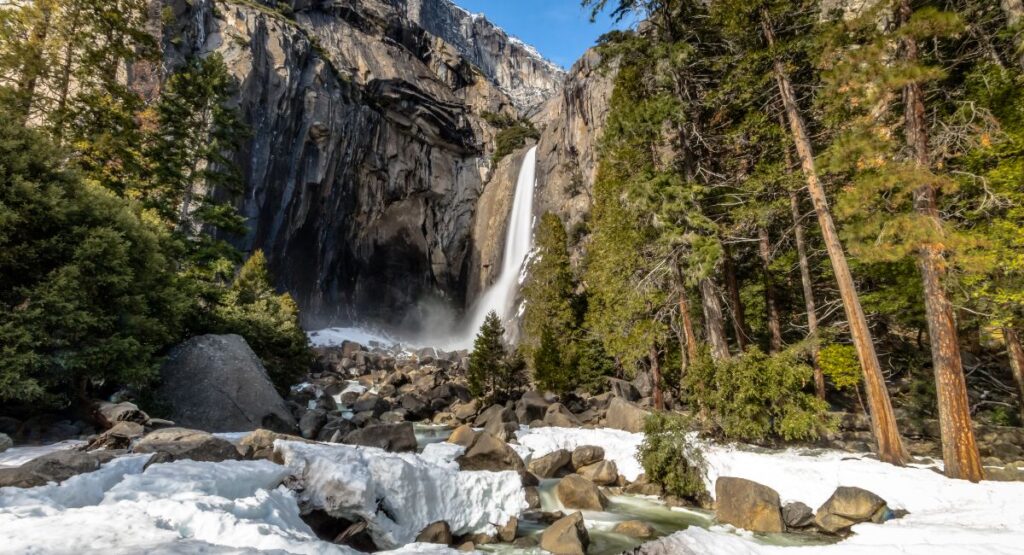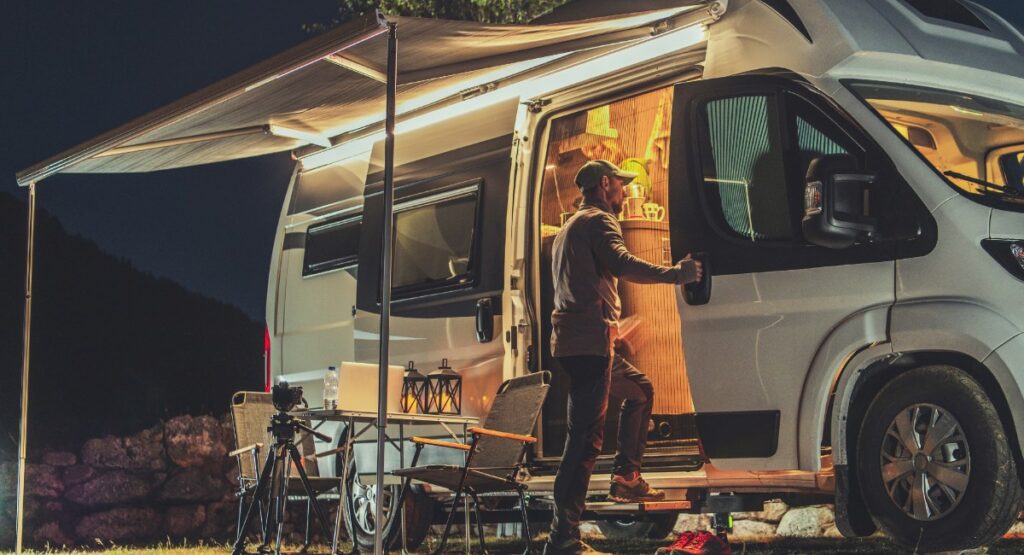“Yosemite Valley, to me, is always a sunrise, a glitter of green and golden wonder in a vast edifice of stone and space.“
Ansel Adams, American Photographer and Environmentalist.
A trip to Yosemite National Park from San Francisco takes you on a spectacular journey from the cultural mosaic of San Francisco to the natural majesty of Yosemite National Park. This classic American road trip is not just about reaching the iconic park, known for its towering sequoias, thunderous waterfalls, and colossal granite cliffs—it’s also about the experience of traveling in an RV, your home away from home.
This guide will help you prepare for the road trip, which takes approximately four to five hours of continuous driving. We recommend taking adequate breaks in between and stopping to discover some great local spots along the way!
Planning Your Journey
Choosing the Right Vehicle
Selecting a vehicle that suits your needs is crucial for comfort and convenience. Consider size, amenities, fuel efficiency, and maneuverability. An RV is best suited for road trips, as it allows you to get the experience of being on the road but with the added benefits of having a home-on-wheels.
Enjoy the independence of a fully-equipped mobile home, allowing you the freedom to pause where you like and travel at your own pace, all while soaking in the radiant sunshine of California. Take the driver’s seat, cue up your favorite adventure playlist, and make your way to the stunning Yosemite National Park.
Some options for the best RVs for road trips include:
Class A Motorhomes: The Luxurious Choice
Class A motorhomes are the epitome of road trip luxury, offering spacious interiors and top-notch amenities. These large RVs are perfect for families or groups prioritizing comfort and having a bit more budget. With features like full kitchens, bathrooms, and comfortable sleeping quarters, a Class A motorhome is like a home on wheels, ideal for the long journey to Yellowstone and back.
Class B Campervans: Compact and Versatile
Class B campervans are an excellent choice for those who prefer a more nimble and fuel-efficient option. These smaller vehicles are easier to navigate through winding mountain roads. They can access more remote camping spots that larger RVs can’t. While they offer limited space compared to Class A motorhomes, they are well-designed with essential features for a comfortable journey, making them ideal for couples or solo travelers.
Class C Motorhomes: The Middle Ground
Class C motorhomes strike a balance between Class A’s spaciousness and Class B’s maneuverability. They provide ample living space, including separate areas for sleeping, dining, and relaxation, without being too cumbersome to drive. This makes them a great option for families or groups looking for a comfortable trip with more flexibility in where they can travel.
Travel Trailers: Versatile and Detachable
Travel trailers offer the flexibility of detaching your living quarters from your vehicle, allowing you to set up camp and use the towing vehicle for local exploration. They come in various sizes, from compact models perfect for couples to larger options suitable for families. Travel trailers require a capable towing vehicle, so ensure your truck or SUV has the necessary power and towing capacity.
Fifth Wheel Trailers: Spacious and Stable
Fifth-wheel trailers provide extensive living space and are known for their stability on the road, thanks to the gooseneck connector. They often feature luxury amenities similar to Class A motorhomes, including full-sized kitchens and multiple sleeping areas. A fifth wheel is ideal for those who want the comfort of a large RV with the option to detach and explore their surroundings in the towing vehicle.
Route Planning and Top Stops on Your San Francisco to Yellowstone RV Road Trip
Mapping out your route from San Francisco, CA to Yosemite National Park with these fun and engaging stops will transform your drive into an unforgettable journey.
Here’s how you can enjoy these destinations in the order they appear along your route. The map given below also features some of the best RV-friendly campgrounds in Yosemite. You’ll read more about them later in this blog!
Oakland Zoo, Oakland
Kick off your journey with a visit to the Oakland Zoo, a highlight for families and wildlife enthusiasts alike. This zoo is celebrated for its dedication to animal welfare and conservation. Explore exhibits that span several global ecosystems, offering close encounters with species from around the world.
Blackhawk Museum, Danville
Drive east towards Danville to visit the Blackhawk Museum, a gem for automobile aficionados and cultural history enthusiasts. The museum showcases an impressive array of classic cars presented in pristine condition alongside exhibits that explore various cultural and historical themes.
Coyote Hills Regional Park, Fremont
Alternatively, you can visit Coyote Hills Regional Park in Fremont before you visit the Blackhawk Museum. This park offers ecological and geological features, with its marshlands and rolling hills providing perfect trails for hiking and biking. It’s an excellent spot for a peaceful retreat into nature and bird-watching.
Livermore Valley Wine Country, Livermore
Next, venture into the heart of California’s wine region with a stop in Livermore Valley. Known for its award-winning wineries and vineyards, this area offers tastings, tours, and stunning vineyard views. It’s a great place to unwind and indulge in some of California’s best wines.
Ironstone Vineyards, Murphys
If you skip the stop in Livermore, you’ll have another chance to explore the wines in the area. As you head further into the Sierra Nevada foothills, stop at Ironstone Vineyards in Murphys. You can taste their exquisite wines and explore their beautifully landscaped grounds, complete with a historical gold mining exhibit and a striking amphitheater.
Columbia State Historic Park
Continue your historical journey at Columbia State Historic Park. This preserved Gold Rush town offers a unique step back with its 1850s buildings, stagecoach rides, and costumed actors. It’s a lively, interactive experience that captures the era’s spirit.
Tunnel View, Yosemite
Conclude your scenic drive with a stop at Tunnel View, one of the most iconic vistas in Yosemite National Park. This viewpoint offers a breathtaking panorama of the valley, including the majestic El Capitan and the Half Dome. It’s a perfect spot for capturing photos and soaking in the awe-inspiring beauty of Yosemite.
Each stop on this route offers unique experiences, making the drive from San Francisco, CA, to Yosemite National Park not just a journey but a series of discoveries. Plan your stops according to your interests and seasonal events to maximize your road trip adventure.
Vehicle Readiness
Ensure your RV is in top condition with a thorough check-up focusing on engine performance, tire integrity, brake function, and fluid levels. Regular maintenance and addressing mechanical issues beforehand prevent roadside troubles and ensure a safer trip.
Note: If you’re planning a trip to Yosemite Mariposa County in 2024, you may need to make a Temporary Peak Hours Vehicle Reservation to enter Yosemite National Park. A vehicle reservation will be required for entry during the following days in 2024:
- April 13 to June 30: On weekends (Saturday and Sunday) and holidays from 5 am to 4 pm.
- July 1 to August 16: Seven days a week from 5 am to 4 pm.
- August 17 to October 27: On weekends (Saturday and Sunday) and on Monday holidays from 5 am to 4 pm.
In the past, Temporary Peak Hours Vehicle Reservation allocations have filled quickly, so make your reservation as soon as possible via Recreation.gov
Packing Essentials
Packing wisely is vital for a comfortable and enjoyable trip. Here are some packing tips and tricks for your RV road trip from San Francisco to Yosemite:
- Space-Saving Essentials: Utilize space-saving items like collapsible kitchenware, vacuum-sealed bags for clothes, and multi-functional furniture.
- Food and Cooking Supplies: Plan your meals and pack accordingly. Bring non-perishable food items and stock up on fresh produce when possible. Don’t forget cooking utensils, portable grills, or camp stoves.
- Emergency Kit and Tools: Include a first-aid kit, essential repair tools, extra batteries, flashlights, and emergency road assistance tools. Ensure your RV has a spare tire and the necessary equipment to change it.
- Entertainment and Leisure Items: Bring books, games, fishing gear, hiking equipment, or bikes to enjoy the diverse landscapes and activities along the way.
- Navigation Aids: Carry updated maps, a GPS device, and guidebooks for national parks and campgrounds. Mobile apps can also help you find RV-friendly routes and amenities.
- Essential Documents: Carry all necessary documents, including driver’s license, RV insurance, vehicle registration, and reservation confirmations.
- Water and Fuel: Have a sufficient water supply and monitor your fuel levels, knowing that gas stations may be sparse in remote areas.
- Respect Wildlife and Nature: Pack binoculars for wildlife viewing and ensure you have bear-proof containers for food storage in Yellowstone.
- Stay Connected: Consider a portable Wi-Fi hotspot or ensure your phone plan covers the areas you will be traveling through, especially in remote locations where signals can be weak.
Exploring Yosemite National Park
Must-Visit Attractions and Things to Do in Yosemite
Yosemite Valley: Yosemite Valley is the crown jewel of the park, home to some of the most famous landmarks. Here, you can see iconic sites like:
- El Capitan: A massive granite monolith that’s popular with rock climbers from around the world. A favorite attraction for those fans of the hit documentary ‘Free Solo’ starring famous rock climber Alex Honnold.
- Half Dome: Known for its unique shape, it’s a challenging hike for many, with cable routes leading to the summit.
- Yosemite Falls: The highest waterfall in North America, best viewed in late spring when it’s at its peak flow.

Glacier Point
An overlook with a breathtaking view of Yosemite Valley, Half Dome, Yosemite Falls, and the High Sierra. It’s accessible by car during the warmer months and is a popular spot for sunrise and sunset.
Mariposa Grove of Giant Sequoias
Home to over 500 mature giant sequoias, this area provides a humbling experience as you walk among some of the largest living beings on Earth. The Grizzly Giant and California Tunnel Tree are must-sees.
Tioga Pass and Tuolumne Meadows
A scenic drive through the high country of Yosemite, Tioga Pass offers access to alpine landscapes and is the gateway to Tuolumne Meadows. Here, you can enjoy hiking, rock climbing, and stargazing away from the valley crowds.
Mirror Lake
A small, seasonal lake that offers a reflective view of Half Dome. It’s a relatively easy hike and a great relaxing day or picnic spot. The lake is most full in the spring and early summer.
Mist Trail
One of the most popular hiking trails in Yosemite leads to Vernal and Nevada Falls. It’s especially magical in the spring when the water flow is strong and the mist from the falls cools hikers.
Hetch Hetchy Reservoir
Located in the northwest corner of Yosemite, this area offers a quieter alternative to the more frequented spots in the park. The reservoir is surrounded by stunning granite cliffs and waterfalls, including the impressive Wapama Falls.
Rock Climbing
Yosemite is a world-renowned climbing destination. Whether you’re a seasoned climber or a beginner, the park has loads to offer. Climbing schools and guided climbs are available for newcomers. If you’re a climber, check out the newly reopened Yosemite Climbing Museum.
Stargazing
Due to its remote location and minimal light pollution, Yosemite is an excellent place for stargazing. The new moon phase is ideal for observing the Milky Way and countless constellations.
Seasonal Activities
Depending on the time of year, you can engage in various seasonal activities such as skiing and snowshoeing in the winter at Badger Pass Ski Area or swimming and rafting in the Merced River during the summer months.
Yosemite RV Camping

With its exceptional camping opportunities, Yosemite is a highlight of any road trip through California. As you approach Yosemite Valley, be mesmerized by your first view through Tunnel View on Highway 41. Follow the graceful flow of the Merced River from the canyon, craning your neck to see the majestic El Capitan. Open your windows to the refreshing scent of pine trees and prepare to be captivated by Yosemite’s iconic vistas, expansive forests, and towering granite cliffs. Find an RV today for your Yosemite RV camping trip.
Yosemite RV Camping Within the Park
Only designated campgrounds within Yosemite National Park permit RV camping. Overnight stays at the roadside or parking lot are not allowed. Due to high demand, reserving a campsite can be competitive.
Securing a Yosemite RV Camping Reservation
Planning ahead by securing a reservation for RV camping in Yosemite during peak summer months can be challenging. Due to the park’s popularity, campsites fill up within minutes of becoming available. Yosemite National Park campgrounds are booked through recreation.gov.
Reservations open at 7 am PT on the 15th, five months before your intended stay date. For example, reservations for a stay between June 15 and July 14 open on February 15. Campgrounds with this reservation schedule include Upper Pines, Lower Pines, North Pines, Wawona, and Hodgdon Meadow.
Two months before your stay, additional reservations for Crane Flat and Bridalveil Creek become available on the 15th. Tamarack Flat and White Wolf release some of their campsites daily two months before the reservation date.
Campground Options: Yosemite provides various campgrounds suitable for RVs of different sizes:
- Upper Pines, Lower Pines, and North Pines: Located in the heart of Yosemite Valley, offering spots for various RV sizes, though space is more limited for larger RVs.
- Wawona and Hodgdon Meadow: Available year-round, suitable for RVs up to 35 feet.
- Crane Flat and Bridalveil Creek: Seasonal availability, accommodating similar RV sizes.
- Camp 4, Yosemite Creek, Porcupine Flat, Tamarack Flat, and White Wolf: Offer more rustic camping experiences with fewer amenities.
Pro Tips for Booking
Ensure your clock is accurate. Be familiar with the dates you need and how to navigate the online system efficiently. Log into the reservation system before 7 am PT to be prepared. Multiple people attempting to book simultaneously increases your chances of securing a site.
Amenities in Yosemite’s RV Campgrounds
Yosemite’s RV campgrounds offer potable water and nearby toilet facilities but no electricity, water, or sewer hookups. Generators are permitted during limited hours to minimize disruption to tent campers.
Campgrounds Suitable for RVs
Most campgrounds can accommodate smaller RVs. Specific campgrounds allow RVs up to certain lengths, and only a few sites in Yosemite Valley can fit large RVs.
Navigating Yosemite with an RV
Large RVs face maneuvering challenges within and outside the park due to tight turns and space constraints. Roads have size limits, and certain roads restrict trailers altogether.
Alternative RV Campgrounds Near Yosemite
If in-park camping is full, nearby Mariposa County offers additional RV camping options with better availability and facilities like hookups and pull-through sites.
Exploring Beyond Yosemite
Don’t miss out on other nearby attractions like Lake McClure and Lake McSwain, where you can enjoy water activities and less crowded camping options. These sites offer a more secluded environment, perfect for those looking to escape the busier park campgrounds.
Start Planning Your San Fran to Yosemite RV Trip Today
Planning, preparation, and flexibility are key to a successful RV road trip. Staying informed about road conditions, weather forecasts, and local regulations while being open to spontaneous discoveries ensures a memorable and enjoyable journey.
Stay updated with the latest in-park road conditions to ensure a smooth and enjoyable stay.
FAQs about Yosemite National Park from San Francisco
The ideal time to visit Yosemite National Park from San Francisco is late spring to early fall. This period offers pleasant weather, accessible trails, and full access to the park’s attractions.
The journey from San Francisco to Yosemite typically takes about 4 hours by car, covering around 170 miles. Traffic can vary, so it’s wise to check current conditions before departing.
Entry reservations to Yosemite are required during peak visitor seasons to manage crowd sizes and ensure a pleasant visit. Check the official Yosemite National Park website for the latest reservation requirements and travel tips.
Pets in Yosemite National Park are allowed in developed areas, fully paved roads, and some campgrounds, but not on the trails or the backcountry.

